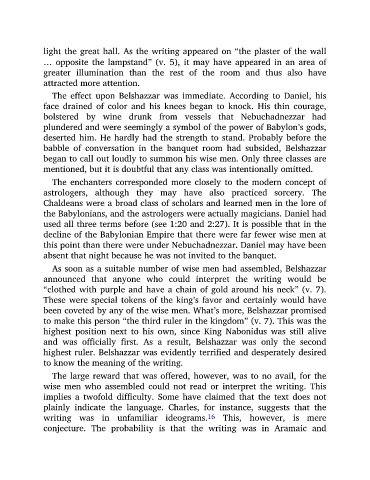Page 144 - Daniel
P. 144
light the great hall. As the writing appeared on “the plaster of the wall
… opposite the lampstand” (v. 5), it may have appeared in an area of
greater illumination than the rest of the room and thus also have
attracted more attention.
The effect upon Belshazzar was immediate. According to Daniel, his
face drained of color and his knees began to knock. His thin courage,
bolstered by wine drunk from vessels that Nebuchadnezzar had
plundered and were seemingly a symbol of the power of Babylon’s gods,
deserted him. He hardly had the strength to stand. Probably before the
babble of conversation in the banquet room had subsided, Belshazzar
began to call out loudly to summon his wise men. Only three classes are
mentioned, but it is doubtful that any class was intentionally omitted.
The enchanters corresponded more closely to the modern concept of
astrologers, although they may have also practiced sorcery. The
Chaldeans were a broad class of scholars and learned men in the lore of
the Babylonians, and the astrologers were actually magicians. Daniel had
used all three terms before (see 1:20 and 2:27). It is possible that in the
decline of the Babylonian Empire that there were far fewer wise men at
this point than there were under Nebuchadnezzar. Daniel may have been
absent that night because he was not invited to the banquet.
As soon as a suitable number of wise men had assembled, Belshazzar
announced that anyone who could interpret the writing would be
“clothed with purple and have a chain of gold around his neck” (v. 7).
These were special tokens of the king’s favor and certainly would have
been coveted by any of the wise men. What’s more, Belshazzar promised
to make this person “the third ruler in the kingdom” (v. 7). This was the
highest position next to his own, since King Nabonidus was still alive
and was officially first. As a result, Belshazzar was only the second
highest ruler. Belshazzar was evidently terrified and desperately desired
to know the meaning of the writing.
The large reward that was offered, however, was to no avail, for the
wise men who assembled could not read or interpret the writing. This
implies a twofold difficulty. Some have claimed that the text does not
plainly indicate the language. Charles, for instance, suggests that the
16
writing was in unfamiliar ideograms. This, however, is mere
conjecture. The probability is that the writing was in Aramaic and

